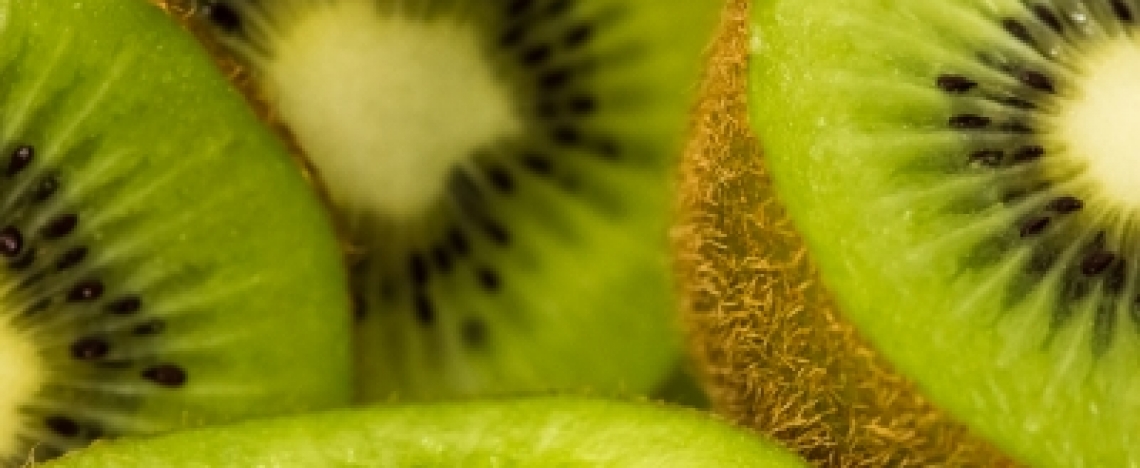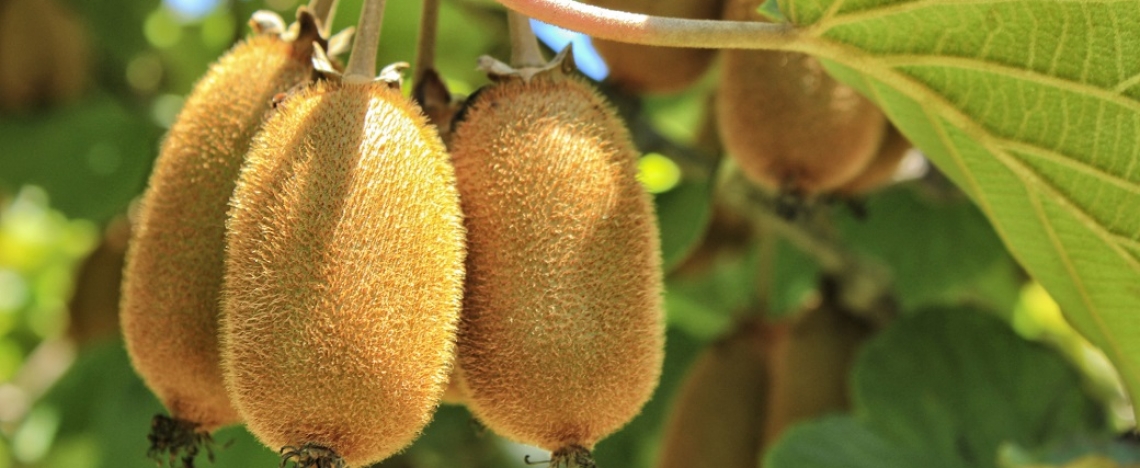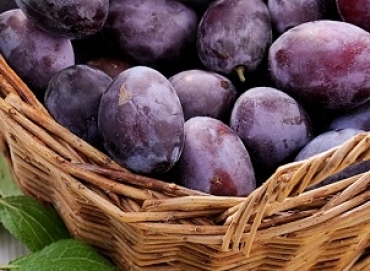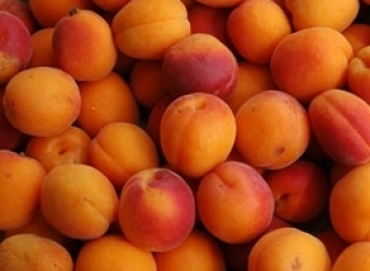Description
The kiwifruit is a little fruit holding great surprises. The most common species of kiwifruit is Actinidia deliciosa, commonly known as Hayward kiwi. Inside of this small, oval-shaped fruit featuring brown fuzzy skin resides a brilliant, semi-translucent emerald green flesh speckled with a few concentrically arranged white veins and small black seeds. Its flesh is almost creamy in consistency with an invigorating taste reminiscent of a mixture of strawberries and bananas, yet with its own unique sweet flavor.
With the growing interest in kiwifruit, other species are now becoming more widely available. These include the hardy kiwi and the silvervine kiwi, two smooth-skinned varieties that are the size of cherries and whose flesh has a golden yellow-green hue.
Botanical Characteristics of kiwifruit
Kiwis are fruits of a vine, called kiwi fruit or Chinese gooseberry (actinidia chinensis or Actinidia deliciosa). It belongs to the family actinidiaceade. It is a bioecious plant (there are male trees and female trees), shrubs and climbers up to 8m high.
Kiwi fruit stems are woody at the bottom and tender and twinning at the top, whose tendrils are used to hook on the support.
Its oval leaves are alternate, long petioled. It bears white female flowers initially, then yellow. The fruits are berries, gathered in clusters. They have a brown skin covered with hair and are oval shaped, its flesh is green and small black seeds are arranged in the circle about the center.
Health Benefits
Kiwifruit can offer a great deal more than an exotic tropical flair in your fruit salad. These emerald delights contain numerous phytonutrients as well as well known vitamins and minerals that promote your health.
Kiwi’s Phytonutrients Protect DNA
In the world of phytonutrient research, kiwifruit has fascinated researchers for its ability to protect DNA in the nucleus of human cells from oxygen-related damage. Researchers are not yet certain which compounds in kiwi give it this protective antioxidant capacity, but they are sure that this healing property is not limited to those nutrients most commonly associated with kiwifruit, including its vitamin C or beta-carotene content. Since kiwi contains a variety of flavonoids and carotenoids that have demonstrated antioxidant activity, these phytonutrients in kiwi may be responsible for this DNA protection.
The protective properties of kiwi have been demonstrated in a study with 6- and 7-year-old children in northern and central Italy. The more kiwi or citrus fruit these children consumed, the less likely they were to have respiratory-related health problems including wheezing, shortness of breath, or night coughing. These same antioxidant protective properties may have been involved in providing protection for these children.
Premier Antioxidant Protection
Kiwifruit emerged from our food ranking system as an excellent source of vitamin C. This nutrient is the primary water-soluble antioxidant in the body, neutralizing free radicals that can cause damage to cells and lead to problems such as inflammation and cancer. In fact, adequate intake of vitamin C has been shown to be helpful in reducing the severity of conditions like osteoarthritis, rheumatoid arthritis, and asthma, and for preventing conditions such as colon cancer, atherosclerosis, and diabetic heart disease. And since vitamin C is necessary for the healthy function of the immune system, it may be useful for preventing recurrent ear infections in people who suffer from them. Owing to the multitude of vitamin C’s health benefits, it is not surprising that research has shown that consumption of vegetables and fruits high in this nutrient is associated with a reduced risk of death from all causes including heart disease, stroke and cancer.
Fiber for Blood Sugar Control Plus Cardiovascular and Colon Health
Our food ranking system also qualified kiwifruit as a very good source of dietary fiber. The fiber in kiwifruit has also been shown to be useful for a number of conditions. Researchers have found that diets that contain plenty of fiber can reduce high cholesterol levels, which may reduce the risk of heart disease and heart attack. Fiber is also good for binding and removing toxins from the colon, which is helpful for preventing colon cancer. In addition, fiber-rich foods, like kiwifruit, are good for keeping the blood sugar levels of diabetic patients under control.
Kiwifruit also passed our food ranking test as a good source of the mineral potassium.
Protection against Asthma
Eating vitamin C-rich fruit such as kiwi may confer a significant protective effect against respiratory symptoms associated with asthma such as wheezing.
A study published in Thorax that followed over 18,000 children aged 6-7 years living in Central and Northern Italy found that those eating the most citrus and kiwifruit (5-7 servings per week) had 44% less incidence of wheezing compared to children eating the least (less than once a week). Shortness of breath was reduced by 32%, severe wheeze by 41%, night time cough by 27%, chronic cough by 25%, and runny nose by 28%.
Children who had asthma when the study began appeared to benefit the most, and protective effects were evident even among children who ate fruit only once or twice a week.
Protection against Macular Degeneration
Your mother may have told you carrots would keep your eyes bright as a child, but as an adult, it looks like fruit is even more important for keeping your sight. Data reported in a study published in the Archives of Opthamology indicates that eating 3 or more servings of fruit per day may lower your risk of age-related macular degeneration (ARMD), the primary cause of vision loss in older adults, by 36%, compared to persons who consume less than 1.5 servings of fruit daily.
In this study, which involved over 110,000 women and men, researchers evaluated the effect of study participants’ consumption of fruits; vegetables; the antioxidant vitamins A, C, and E; and carotenoids on the development of early ARMD or neovascular ARMD, a more severe form of the illness associated with vision loss. Food intake information was collected periodically for up to 18 years for women and 12 years for men. While, surprisingly, intakes of vegetables, antioxidant vitamins and carotenoids were not strongly related to incidence of either form of ARM, fruit intake was definitely protective against the severe form of this vision-destroying disease. Three servings of fruit may sound like a lot to eat each day, but kiwifruit can help you reach this goal. Slice kiwi over your morning cereal, lunch time yogurt or green salads. For a more elegant meal, decorate any fish dish or fruit salad with kiwi slices.
A Delicious Way to Enjoy Cardiovascular Health
Enjoying just a couple of kiwifruit each day may significantly lower your risk for blood clots and reduce the amount of fats (triglycerides) in your blood, therefore helping to protect cardiovascular health.
Unlike aspirin, which also helps to reduce blood clotting but has side effects such as inflammation and bleeding in the intestinal tract, the effects of regular kiwi consumption are all beneficial. Kiwifruit is an excellent source of vitamin C, and polyphenols, and a good source of potassium, all of which may function individually or in concert to protect the blood vessels and heart. In one study, human volunteers who ate 2 to 3 kiwifruit per day for 28 days reduced their platelet aggregation response (potential for blood clot formation) by 18% compared to controls eating no kiwi. In addition, kiwi eaters’ triglycerides (blood fats) dropped by 15% compared to controls.
References: http://www.botanical-online.com http://www.whfoods.com
Fruit Info
- Calories 44
- Vitamins Vitamin C, Fat-soluble vitamins A E, Vitamins complex Β
- Minerals Potassium, Magnesium, Calcium, Phosphorus, Iron, Copper, Zinc
- Fiber Rich
- Fatty Omega-3, omega-6
- Lutein Rich








